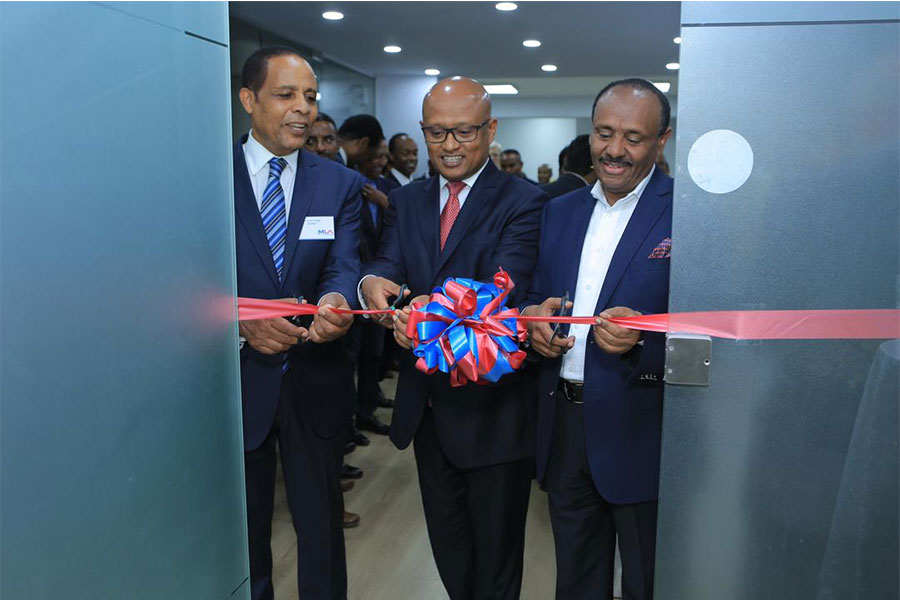
Fortune News | Nov 27,2022
The year 2020 has welcomed the world with the turmoil of the Novel Coronavirus (COVID-19), which started in China and has spread rapidly across the world.
All the New Year's resolutions, expectations, plans and dreams have, in a merciless plot twist, all been replaced with national emergency response plans, cancelled travel plans and lockdowns.
Setting foot on the soil of most countries across the globe, the virus was first reported in Ethiopia in mid-March. A Japanese man, who arrived in Ethiopia from Burkina Faso, was the first person to test positive.
The announcement made by the Ministry of Health triggered YHM Consulting Firm, an eight-year-old company, to find a technological solution that allows humanity to resume life without being in danger.
“When the first case was identified in Ethiopia, I wasn't worried how the virus got to the country," said Yared Haile-Meskel, managing director of YHM Consulting and board member of Arts Television and ZayRide.
The firm, which was established in 2012 and works primarily on helping foreign private equity companies invest in Ethiopia, has also been involved in application development, including the real estate app Bet-Ethiopia that connects sellers and renters with buyers and tenants.
“It’s hard to imagine how many people that person has come into contact with during his travel from Burkina Faso to Ethiopia," said Yared. "Can you imagine that?”
Being a tech guru, Yared took to social media to describe why using technology to trace the pandemic was the best way to combat it, and why Ethio telecom and the Information Network Security Agency (INSA) have a better leg-up, because the institutions can actually track people and find their location.
If the institutions tried to find a solution looking in that direction, the impact of the disease could somehow be traced, according to Yared.
“I have tried communicating with Ethio telecom officially and through social media, but they didn’t get back to me," he said. "So I said 'why don’t we just do this ourselves?'"
Yared then gathered a couple of coders under his consulting firm and started a brainstorming session, and ten days later the COVID-19 Family Protect App came to life.
Yared then gathered a couple of coders under his consulting firm and started a brainstorming session, and ten days later the COVID-19 Family Protect App came to life.
“I have no coding background, but my whole life I was part of product development and research,” Yared said.
The App connects the user's phone to other phones offline or online with a device-to-device signal within a five-metre radius. The App is aware of other phones carried by users, but the phones do not share any information about the individuals in that range.
However, when two people who have the App come within two metres of one another, the App automatically shares their names, phone numbers, travel histories, and any medical info that is relevant to the COVID-19 virus, and the two people receive the other person's information.
The records of the meeting are saved on each user's phone. If a user later tests positive, they can choose whether to send these records to the Ministry of Health to help with efforts to trace the virus. They can also send an alert message to all of the people they have recently met. The application works whether the phone is online or offline as long as the person has allowed the App to access its location.
This will hasten the contact tracing process and quickly inform users of the COVID-19 Family Protection App whether they interacted with a person who has the disease, giving them time to self-isolate and monitor their own health for signs of the virus.
The mobile application is in a beta version and is being tested by Google Play. At the moment, it can only be downloaded for Android phones. It is currently only available in Amharic, but the Afan Oromo, Tigrigna and Somali versions are in the pipeline, along with the iPhone version.
The hardest part was finding the anchor for the exchange of data on the device-device connection, according to Yared. The team worked hard to figure out how to connect the phones so that they automatically throw signals to each other. They chose to use a location detector, whereas apps developed in other countries are using Bluetooth.
The App does not collect or use any data from the user's phone and does not have access to their phone contact list or any other data, according to Yared.
"Data isn't stored in a server for the developers or the government," Yared said. "All the data collected is stored on the user’s phone and remains encrypted."
When a person is confirmed to be positive for the virus, health authorities will ask that person to upload the data to the Ministry of Health to assist in contact tracing efforts. If the user does not come into close contact with the virus, COVID-19 Family Protect App data older than 14 days will be automatically deleted.
“We don’t have access to any data except where users are located when they are online," said Bereket Bayissa, the chief developer of the App and a Chief Technology Officer at ZayRide, whose 500 volunteer drivers from a total of 7,000 ZayRide drivers downloaded the App for testing purposes.
“If the result is satisfying and the government accepts it, it’s going to be rewarding for us,” he added.
The mobile application also has aggregates the information on the travel and medical history of a person that is drawn when a person enters the country and even when a person finishes the due diligence at the designated hospital. People can also insert additional information about their medical and travel history and consent to share the information.
“This will help provide information about those involved in each encounter, helping users decide what to do if they are infected with the virus,” Bereket said.
There are three steps in contact tracing: contact identification, contact listing and contact follow-up, according to the World Health Organization (WHO).
The Ministry of Health defines "close contact" as being near someone who has the virus for more than 15 minutes.
As of last week, the Health Ministry has identified 264 instances of close contact with people that have tested positive. Also, over 3,000 people with travel histories are currently in quarantine.
In China, the strict quarantine, isolation and contact tracing measures were put in place to prevent the overcrowding of the health system with seriously ill cases that even developed countries cannot often treat, according to Bruce Aylward, co-lead of the WHO-China Joint Mission on COVID-19.
COVID-19 Family Protect App also has information on the global status of the pandemic from data extracted from Johns Hopkins University. It also continuously updates users on the status of the virus in the country using data from the Ministry of Health.
“After the official launch of the app, we will be looking for funds to cover the expenses from Google and other overhead costs,” said Yared. "The development of the app didn’t cost more than 50,000 Br, since it was developed in-house."
The developers tried to get their App registered at the Ministry of Health but received an unenthusiastic response, according to Yared.
"We were thrown off by the bureaucracy," he said. "and it was taking too much time, so we went ahead, and we're doing the marketing and expansion of the app by ourselves."
Currently, the best thing individuals can do is adhere to the social distancing guidelines to prevent the spread of the disease. But once cases start popping up everywhere, tracing and quarantine is the best solution, according to Tadele Boglae (MD), a public health expert at Family Health International 360.
“The trick is that contact tracing relies on the infected individual's ability to recall who they were in contact with," he said. "There are many cases in which the interviewee can't remember all their encounters or, in most cases, don’t have any information on those whom they have been in contact with.”
If this is typical of the population as a whole, it will be difficult for the health system to combat the virus, according to him.
The App is an innovative solution that addresses a big problem for the healthcare system, according to Noad Mekonnen, an independent technology consultant with over a decade of experience.
However, the App might not be used by a large percentage of the population, since smartphone penetration is low, according to Noad.
“With a little over four percent of users having smartphones, the application is addressing only a small subset of a group," he said. "Hence, the developers also must work on how to include the non-smartphone users in this bubble."
PUBLISHED ON
Apr 17,2020 [ VOL
21 , NO
1042]

Fortune News | Nov 27,2022

Exclusive Interviews | Jan 07,2024


Radar | Oct 12,2025

Fortune News | Jan 26,2019

Radar | Jan 16,2021

Fortune News | Oct 23,2021

Commentaries | Mar 05,2022

Fortune News | Mar 28,2020

Fortune News | Feb 23,2019

Dec 22 , 2024 . By TIZITA SHEWAFERAW
Charged with transforming colossal state-owned enterprises into modern and competitiv...

Aug 18 , 2024 . By AKSAH ITALO
Although predictable Yonas Zerihun's job in the ride-hailing service is not immune to...

Jul 28 , 2024 . By TIZITA SHEWAFERAW
Unhabitual, perhaps too many, Samuel Gebreyohannes, 38, used to occasionally enjoy a couple of beers at breakfast. However, he recently swit...

Jul 13 , 2024 . By AKSAH ITALO
Investors who rely on tractors, trucks, and field vehicles for commuting, transporting commodities, and f...

Oct 25 , 2025
The regulatory machinery is on overdrive. In only two years, no fewer than 35 new pro...

Oct 18 , 2025
The political establishment, notably the ruling party and its top brass, has become p...

Oct 11 , 2025
Ladislas Farago, a roving Associated Press (AP) correspondent, arrived in Ethiopia in...

Oct 4 , 2025
Eyob Tekalegn (PhD) had been in the Governor's chair for only weeks when, on Septembe...